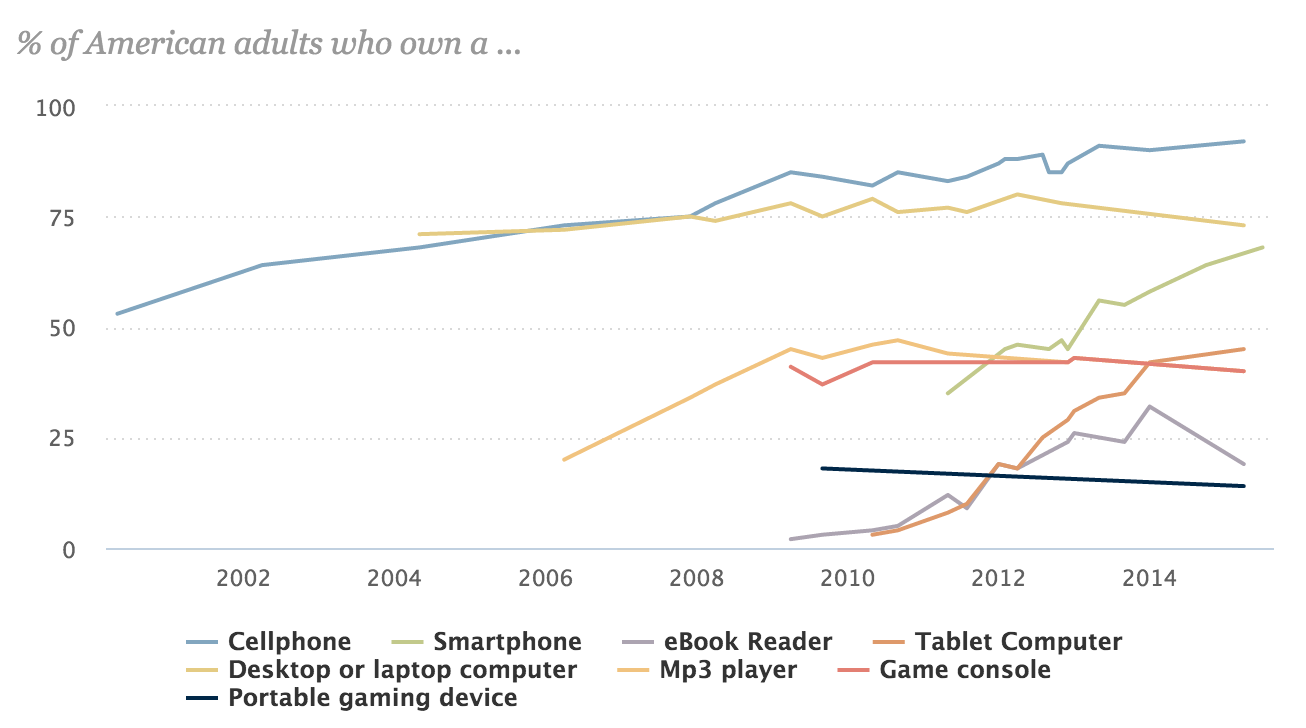Intro
What is Mobile Computing?
According to Wikipedia:
"Mobile computing is human-computer interaction by which a computer is expected to be transported during normal usage."
Mobile Operating Systems are designed specifically for use on mobile devices such a smartphones, tablets, PDA, etc.
Why is it important that we study mobile devices?
The growing infiltration of mobile devices into our daily (for some, hourly) lives is the simplest indicator of their impact on modern society. As the number of mobile devices continues to grow, so does the necessity to ensure that our educational systems evolve in order to produce graduates with knowledge relevant to the world in which we live.
According to the Pew Research Center, as of Oct 2014:
- 90% of American adults have a cell phone
- 64% of American adults have a smartphone
- 29% of cell owners describe their cell phone as "something they can't imagine living without."
(src: http://www.pewinternet.org/fact-sheets/mobile-technology-fact-sheet/)
Also, the types of devices we use (i.e. the way we interact with computers) is changing:

(src: Adult Gadget Ownership Over Time)
Major Mobile Operating Systems
(src: http://www.idc.com/prodserv/smartphone-os-market-share.jsp)

Android:
- World's most widely used Mobile OS
- Based on Linux kernel
- Developed by Android Inc; bought by Google in 2005
- Open source (released under apache license)
- Language: Java and XML
iOS:
- Apple Inc's mobile version of the OSX operating system
- Originally released in 2007 for use on the iPhone, now expanded to include an array of mobile devices (current version is iOS 7)
- Licensed for Apple products only
- Language: Objective-C
Blackberry OS:
- Original version developed by Blackberry Ltd for its Blackberry devices
- Current version (10) based on QNX mobile OS, acquired by Blackberry Inc in 2010
- Language: many options (including an Android runtime layer!)
Windows Phone:
- Developed by Microsoft
- Succeeded Windows Mobile in 2010
- Language: C/C++
Why Android?
- Most popular Mobile OS in the world today
- Open source code based on the Linux kernel
- Develop on any major OS
- Several IDE options:
- SDK Plugins for open-source Eclipse IDE
- note: iOS requires the use of the XCode IDE running in OSX
- No special hardware requirements
- Android emulator (AVD) available for testing
- No need to sign up for an account to test on actual hardware
- Builds on your current knowledge base of object-oriented programming in Java
For you skeptics that still need more convincing that Android is the superior platform, check this out: Android, the world's most popular mobile platform
Android Flavors
One of the most vocalized criticisms about developing for Android is the need to account for many versions of the platform (aka 'fragmentation'). This is a valid concern, because as new versions of the operating system are published, new features become available that may or may not be backwards compatible. At some point you may find that you have to make the hard decision between incorporating some new whiz-bang feature and providing backwards compatibility. The choice is never easy.
Here are the versions of Android:
- 10/2015 - 6.0 - Marshmallow (API Level 23)
- 11/2014 - 5.0 - Lollipop (API Level 21-22)
- 10/2013 - 4.4 - KitKat (API Level 19-20)
- 07/2012 - 4.1 - Jelly Bean (API Level 16-18)
- 10/2011 - 4.0 - Ice Cream Sandwich (API Level 14-15)
- 02/2011 - 3.0 - Honeycomb (API Level 11-13)
- 12/2010 - 2.3 - Gingerbread (API Level 9-10)
- 05/2010 - 2.2 - Froyo (API Level 8)
- 10/2009 - 2.0 - Eclair (API Level 5-7)
- 09/2009 - 1.6 - Donut (API Level 4)
- 04/2009 - 1.5 - Cupcake (API Level 3)
- 02/2009 - 1.1 - Beta - (API Level 2)
- 09/2008 - 1.0 - Alpha - (API Level 1)
For a complete history, see here: Android History
The API level is important because when building apps, you specify minimum and target API levels. Your app cannot be installed on any device that has an OS version with an API level lower than the minimum you specify. So how low do you go? Where is the sweet spot in terms of determining how many devices you will support? That depends on you, but in making your decision, it makes sense to have a look at the current install statistics (i.e. your user base).
As of 4 January 2016, more than 94% of running Android devices are running API Level 16 (Jelly Bean) or higher. (*source: http://developer.android.com/about/dashboards/index.html)
As if multiple versions of the operating system weren't enough fragmentation, there are also multiple screen sizes and display densities that you need to consider during development. An app written for a smartphone may not look right on a tablet, or vice-versa. For that reason, it's crucial that you test your apps on multiple devices before ever thinking about publishing. We'll discuss ways to account for different screen sizes when we get to Layouts.
Conclusion
Developing for mobile devices using the Android operating system is highly rewarding, and can result in widespread usage. However, with power comes responsibility. Being an open ecosystem, you have plenty of options in terms of device support and OS functionality. There's also a fairly steep learning curve as you become familiar with the organization of the system and the relationship of its many parts. However, if you stick with it and give each lesson its due diligence, the end result will be a skill that you can take with you wherever you may go.
